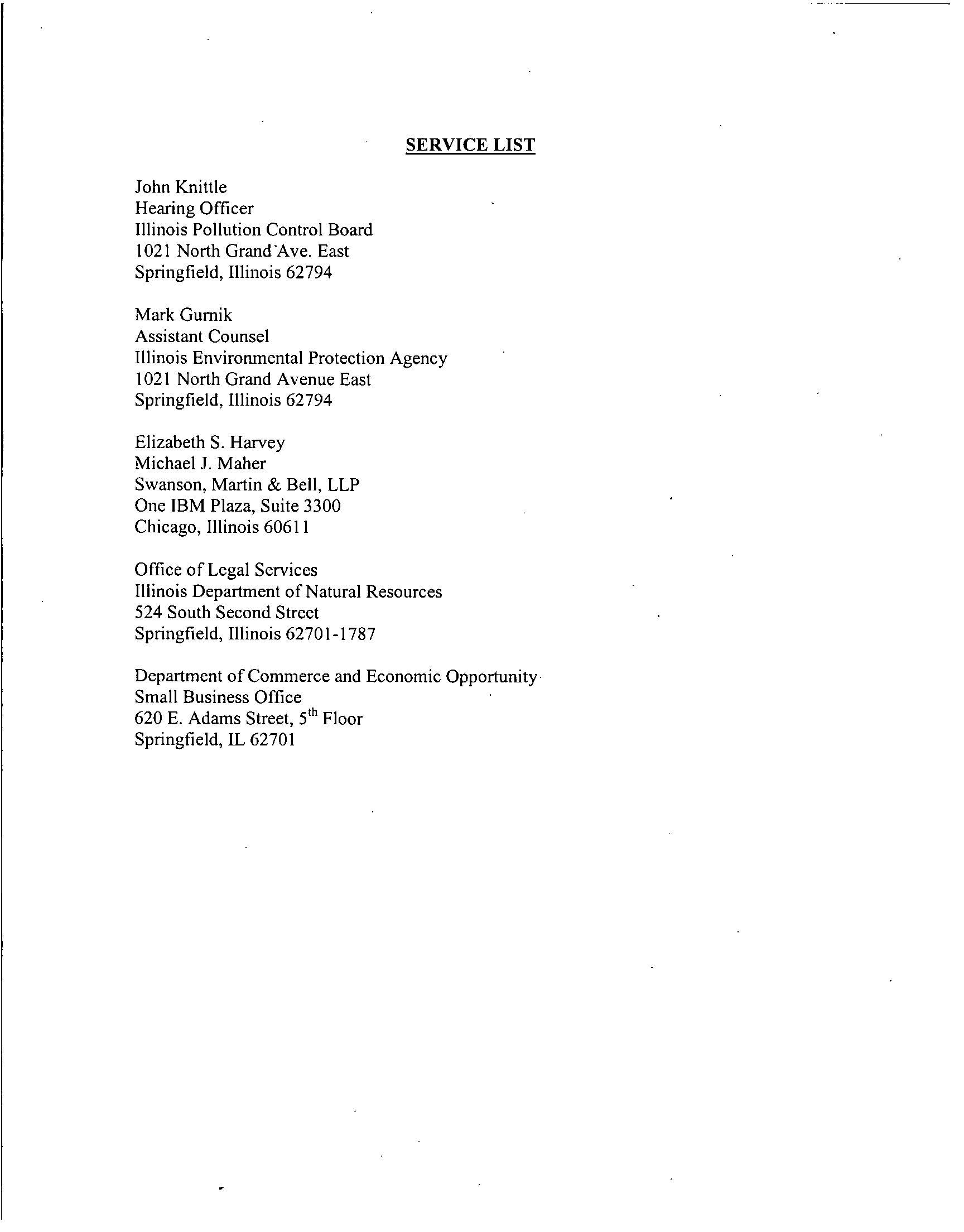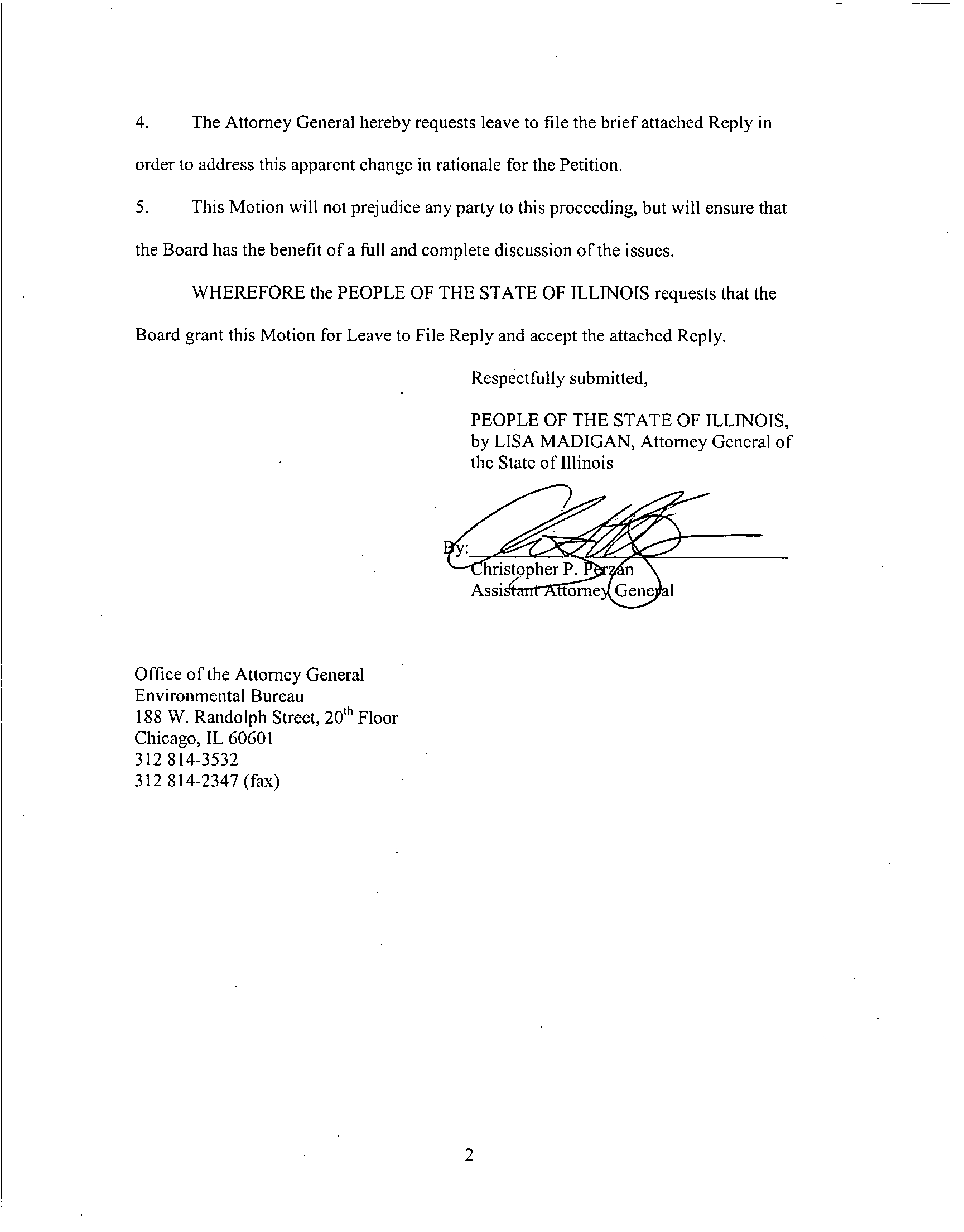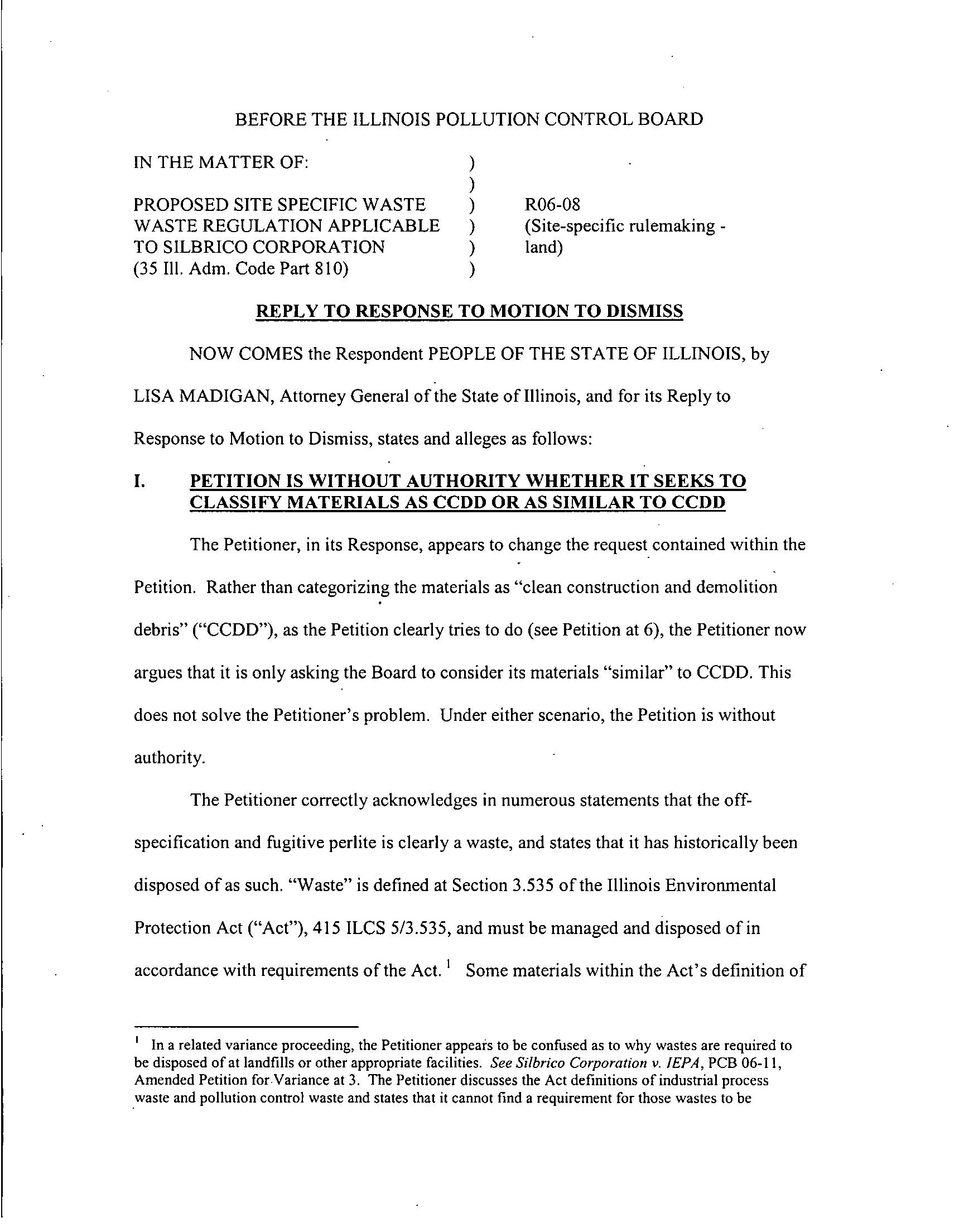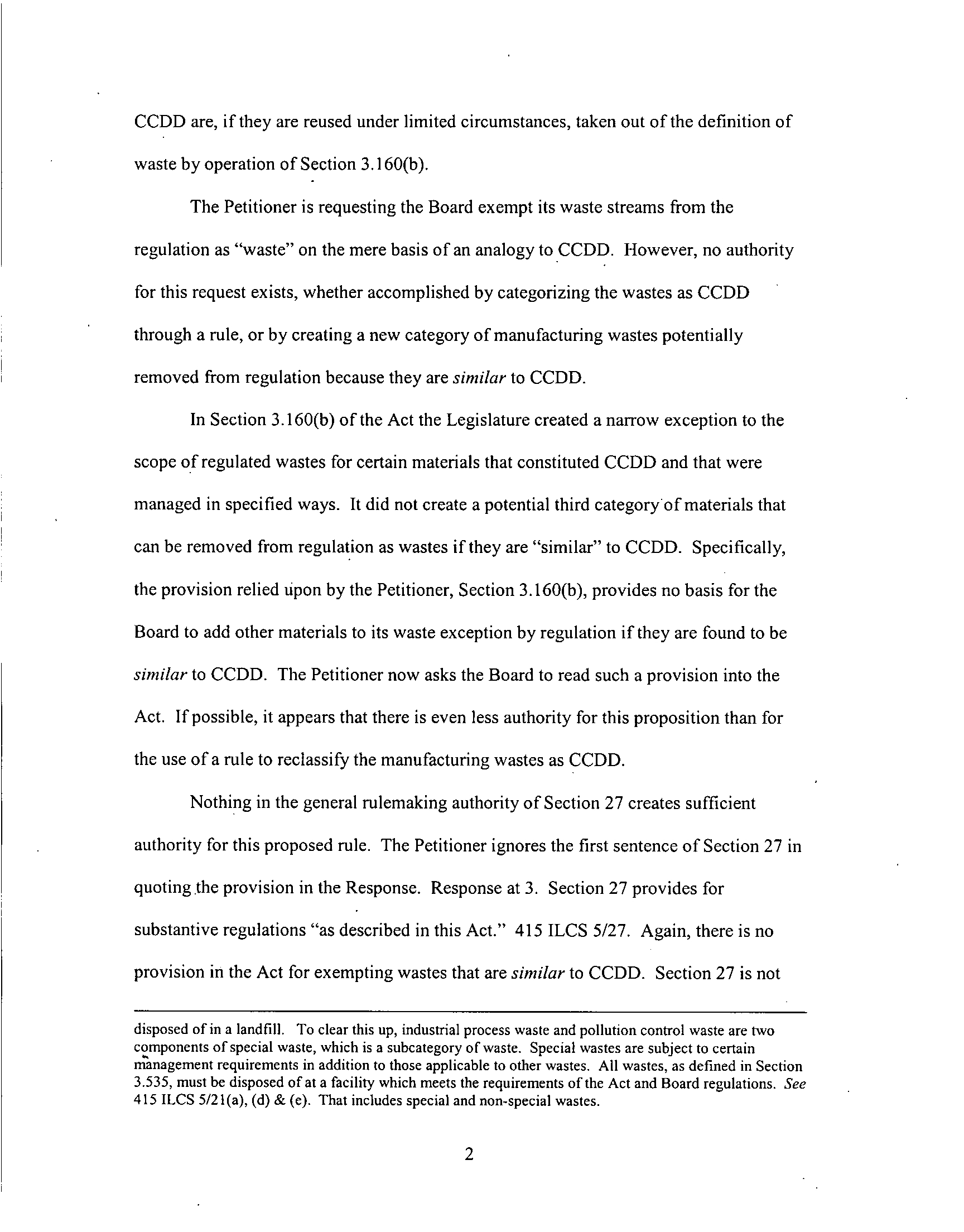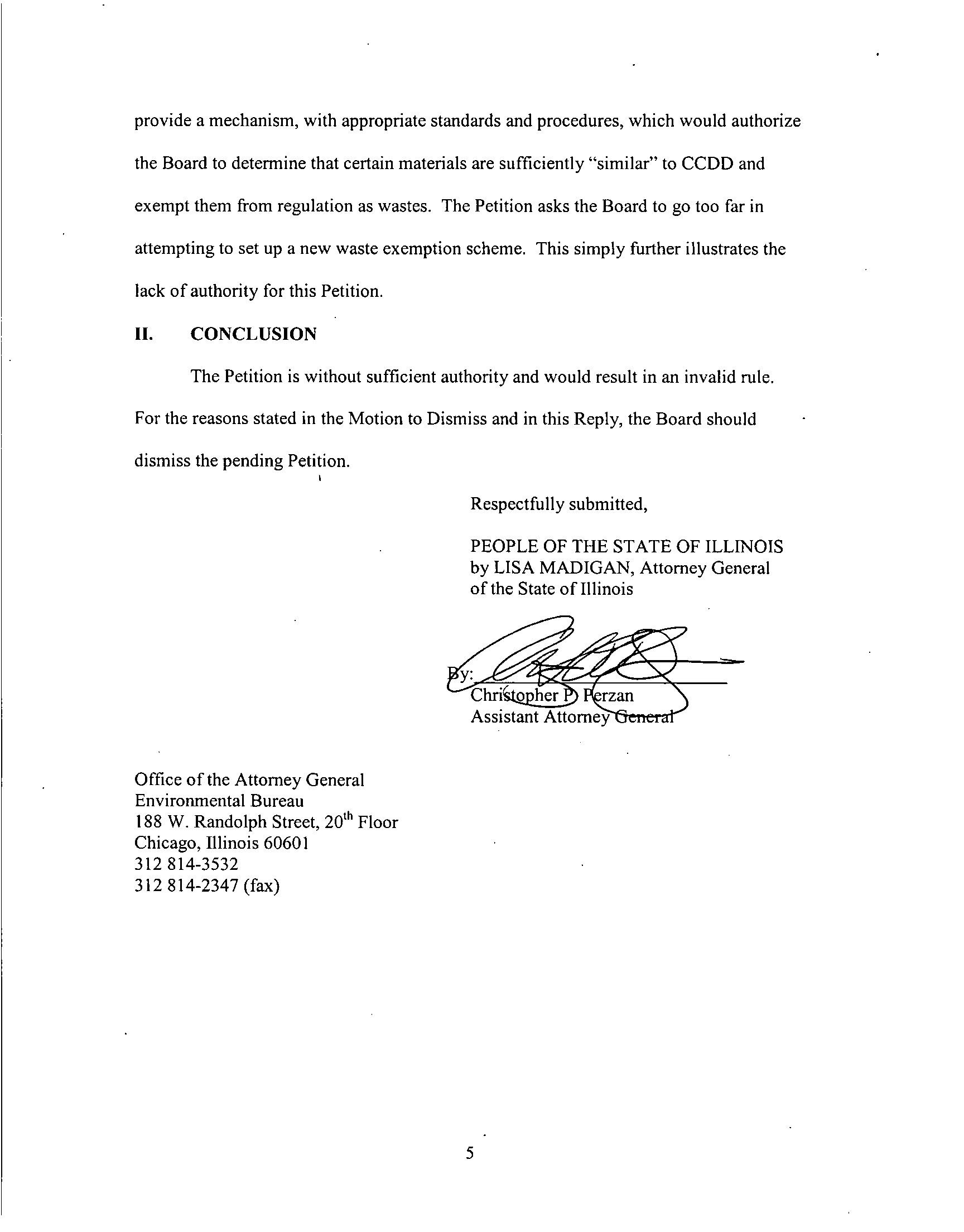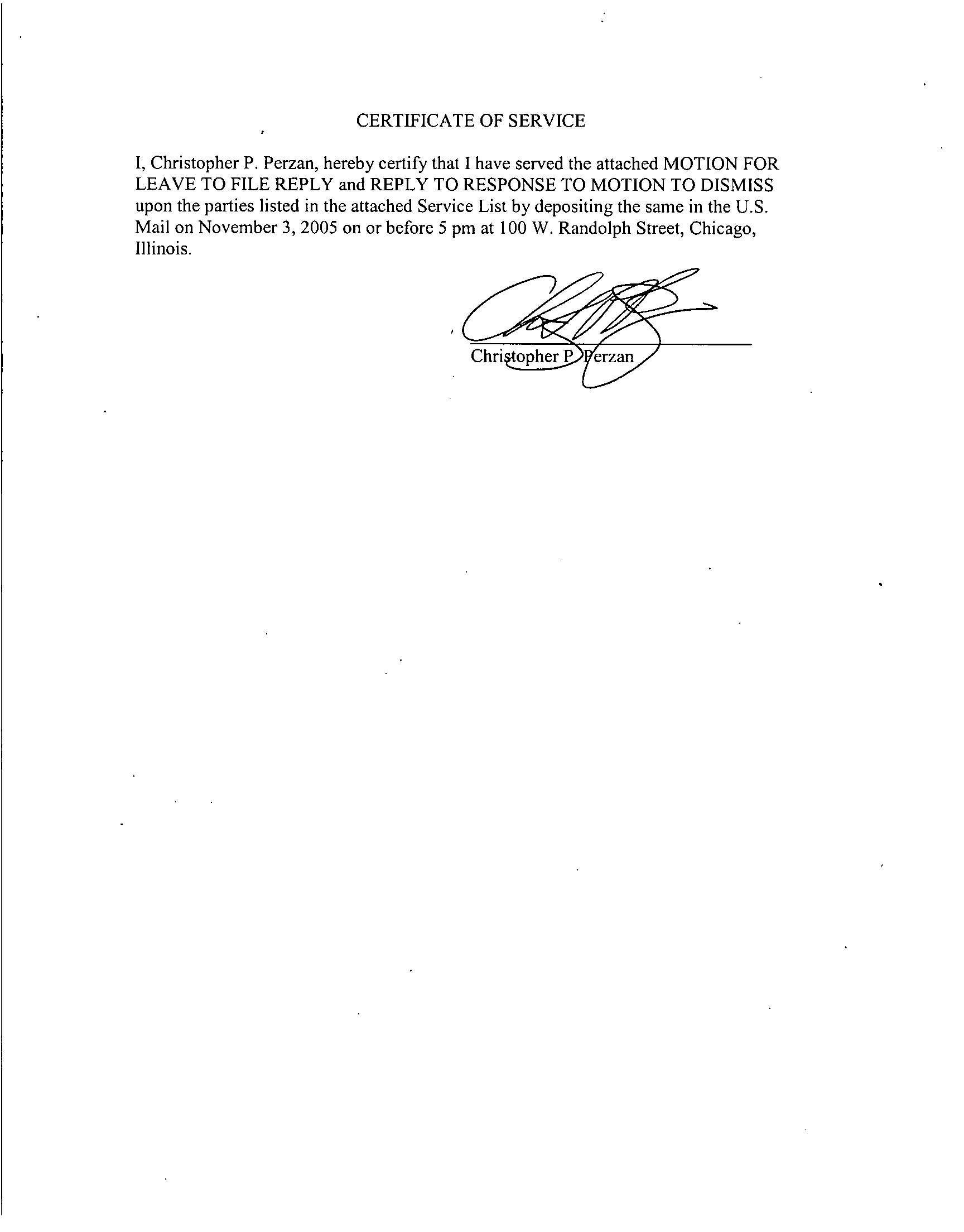BEFORE THE ILLINOIS POLLUTION CONTROL BOARD
IN THE MATTER OF:)
PROPOSED SITE SPECIFIC WASTE
)
R06-08
WASTE REGULATION APPLICABLE
)
(Site-specific milemaking
-
TO SILBRICO CORPORATION
)
land)
(35 III. Adm. Code Part 810))
NOTICE OF FILING
TO:
Attached service list
PLEASE TAKE NOTICE that we have oh November 3, 2005, electronically filed the
attached MOTION FOR LEAVE TO FILE REPLY and REPLY TO RESPONSE TO
MOTION TO DISMISS with the Clerk of the Illinois Pollution Control Board, copies of
which are hereby served upon you.
Office of the Attorney General
Environmental Bureau
188 W. Randolph Street,
20th
Floor
Chicago, Illinois 60601
312 814-3532
THIS FILING IS SUBMITTED ON RECYCLED PAPER
ELECTRONIC FILING; RECEIVED, CLERK'S OFFICE, NOVEMBER 3, 2005
SERVICE LIST
John Knittle
Hearing
Officer
Illinois Pollution Control Board
1021 North GrandAve. East
Springfield, Illinois 62794
Mark Gumik
Assistant Counsel
Illinois Environmental Protection Agency
1021 North Grand Avenue East
Springfield, Illinois 62794
Elizabeth S. Harvey
Michael
J.
Maher
Swanson, Martin & Bell, LLP
One IBM Plaza, Suite 3300
Chicago, Illinois 60611
Office of Legal Services
Illinois Department of Natural Resources
524 South Second Street
Springfield, Illinois 6270 1-1787
Department of Commerce and Economic Opportunity
Small Business
Office
620 E. Adams Street,
5th
Floor
Springfield, IL 62701
ELECTRONIC FILING; RECEIVED, CLERK'S OFFICE, NOVEMBER 3, 2005
BEFORE THE ILLINOIS POLLUTION CONTROL BOARD
IN THE MATTER OF:)
PROPOSED SITE SPECIFIC WASTE
)
R06-08
WASTE REGULATION APPLICABLE
)
(Site-specific rulemaking
-
TO SILBRICO CORPORATION
)
land)
(3 5
III1. Adm. Code Part SI10))
MOTION FOR LEAVE TO FILE REPLY
NOW COMES the PEOPLE OF THE STATE OF ILLINOIS, by LISA
MADIGAN, Attorney General of the State of Illinois, and for its Motion for Leave to File
Reply, states and alleges as follows:
I .
The rules of the Illinois Pollution Control Board do not ordinarily contemplate
parties filing replies to responses.
However, in this instance, for the following reasons,
the Attorney General's'Office requests leave to
file
the attached reply.
2.
In Petitioner Silbrico Corporation's Response to Motion to Dismiss, the Petitioner
makes an argument that appears to change the basis for the Petition.
In the Petition, the
Petitioner stated that "Silbrico seeks this site-specific rule to allow it to dispose of waste
streams as 'clean construction and demolition debris."' Petition at 6.
That language is a
fairly unambiguous request for the Board to classify its wastes "as 'clean construction
and demolition debris."'
3.
However, in response to the Motion to Dismiss, the Petitioner now argues that it
is not requesting that the Board classify the material as clean construction and demolition
debris, but as analogous or similar to clean construction and demolition debris and
characterizes the Motion to Dismiss as having misunderstood the Petition.
Response at
4-5.
ELECTRONIC FILING; RECEIVED, CLERK'S OFFICE, NOVEMBER 3, 2005
4.
The Attorney General hereby requests leave to file the brief attached Reply in
order to address this apparent change in rationale for the Petition.
5.
This Motion will not prejudice any party to this proceeding, but will ensure that
the Board has the benefit of a full and complete discussion of the issues.
WHEREFORE the PEOPLE OF THE STATE OF ILLINOIS requests that the
Board grant this Motion for Leave to File Reply and accept the attached Reply.
Respectfully submitted,
PEOPLE OF THE STATE OF ILLINOIS,
by LISA MADIGAN, Attorney General of
the State of Illinois
Office of the Attorney General
Environmental Bureau
188 W. Randolph Street,
2 0 th
Floor
Chicago, IL 60601
312
814-3532
312 814-2347 (fax)
2
ELECTRONIC FILING; RECEIVED, CLERK'S OFFICE, NOVEMBER 3, 2005
BEFORE THE ILLINOIS POLLUTION CONTROL BOARD
[N THE MATTER OF:
PROPOSED SITE SPECIFIC WASTE
)
R06-08
WASTE REGULATION APPLICABLE
)
(Site-specific rulemnaking
-
TO SILBRICO CORPORATION
)
land)
(3
5
III1.
Adm. Code Part 8 10))
REPLY TO RESPONSE TO MOTION TO DISMISS
NOW COMES the Respondent PEOPLE OF THE STATE OF ILLINOIS, by
LISA MADIGAN, Attorney General of the State of Illinois, and for its Reply to
Response to Motion to Dismiss, states and alleges as follows:
I.
PETITION IS WITHOUT AUTHORITY WHETHER IT SEEKS TO
CLASSIFY MATERIALS AS CCDD OR AS SIMILAR TO CCDD
The Petitioner, in its Response, appears to change the request contained within the
Petition.
Rather than categorizing the materials as "clean construction and demolition
debris" ("CCDD"), as the Petition clearly tries to do (see Petition at 6), the Petitioner now
argues that it is only asking the Board to consider its materials "similar" to CCDD. This
does not solve the Petitioner's problem.
Under either scenario, the Petition is without
authority.
The Petitioner correctly acknowledges in numerous statements that the
off-
specification and fugitive perlite is clearly a waste, and states that it has historically been
disposed of as such. "Waste" is defined at Section 3.535 of the Illinois Environmental
Protection Act ("Act"), 415 ILCS 5/3.535, and must be managed and disposed of in
accordance with requirements of the Act. 1Some materials within the Act's definition of
In a related variance proceeding, the Petitioner appears to be confused as to why wastes are required to
be disposed of at landfills or other appropriate facilities.
See Silbrico Corporation v. JEPA,
PCB 06-1Il,
Amended Petition for Variance at 3. The Petitioner discusses the Act definitions of industrial process
waste and pollution control waste and states that it cannot find a requirement for those wastes to be
ELECTRONIC FILING; RECEIVED, CLERK'S OFFICE, NOVEMBER 3, 2005
CCDD are, if they are reused under limited circumstances, taken out of the definition of
waste by operation of Section 3.160(b).
The Petitioner is requesting the Board exempt its waste streams from the
regulation as "waste" on the mere basis of an analogy to CCDD.
However, no authority
for this request exists, whether accomplished by categorizing the wastes as CCDD
through a rule, or by creating a new category of manufacturing wastes potentially
removed from regulation because they are
similar
to CCDD.
In Section 3.160(b) of the Act the Legislature created a narrow exception to the
scope of regulated wastes for certain materials that constituted CCDD and that were
managed in specified ways.
It did not create a potential third category of materials that
can be removed from regulation as wastes if they are "similar" to CCDD.
Specifically,
the provision relied iipon by the Petitioner, Section 3.160(b), provides no basis for the
Board to add other materials to its waste exception by regulation if they are found to be
similar
to CCDD.
The Petitioner now asks the Board to read such a provision into the
Act.
If possible, it appears that there is even less authority for this proposition than for
the use of a rule to reclassify the manufacturing wastes as CCDD.
Nothing in the general rulemaking authority of Section 27 creates sufficient
authority for this proposed rule.
The Petitioner ignores the first sentence of Section 27 in
quoting .the provision in the Response.
Response at 3. Section 27 provides for
substantive regulations "as described in this Act."
415
ILCS
5/27.
Again, there is no
provision in the Act for exempting wastes that are
similar
to CCDD.
Section 27 is not
disposed of in a landfill.
To clear this up, industrial process waste and pollution control waste are two
components of special waste, which is a subcategory of waste.
Special wastes are subject to certain
management requirements
in addition to those applicable to other wastes.
All wastes, as defined in Section
3.535, must be disposed of at a facility which meets the requirements of the Act and Board regulations.
See
415 ILCS 5/2 1(a), (d) & (e).
That includes special and non-special wastes.
2
ELECTRONIC FILING; RECEIVED, CLERK'S OFFICE, NOVEMBER 3, 2005
blanket authority for the proposal of any regulation; regulations have to be consistent
with the provisions in the Act.
Where the Act sets out clear statutory standards for the
regulation of wastes with a limited exception, the Petitioner cannot through a rule seek to
create a new exception to the statutory scheme where one is not provided for in the Act.
The Petitioner is simply incorrect in asserting that there would be no conflict
between the proposed rule and the Act.
The conflict would explicitly arise if the Board
issues a rule stating that a waste does not have to be disposed of as a waste when, under
the Act, it is a waste and must be managed as such.
That is exactly what the Petitioner's
proposed language does:
it
provides that "waste streams
" may be disposed of at a facility
that is not required
to have a waste
management
permit or meet requirements of a solid
waste management facility.
Petition at'3.
Such language would set up an explicit conflict
between the rule and the Act.
The fact that this request is characterized as site-specific does not make a
difference and is somewhat misleading.
This Petition would impermnissibly expand the
authority
to remove materials from regulation as wastes.
To grant this Petition, the Board
would have to find within the Act the authority to "delist" wastes if they are similar to
clean construction and demolition debris.
This expansion of authority is unauthorized,
whether it extends to one site alone, or to multiple sites.
Furthermore, the Petition really
isn't site-specific.
Petitioner does not identify or limit disposal
to
any specific disposal
site.
Presumably it would be able to dispose of these materials at any "clean fill" site.
2
2
In a related variance petition, the Board previously
pointed
out that
the Petitioner did
not
define a
"clean
fill" facility.
Silbrico Corporation v. 1EPA,
PCB
06-11 (September
1, 2005).
The
lack of definition is
also
an issue
in the
present matter,
which
the
AGO
reserves the
right
to
address
should the
Board allow this
Petition to proceed.
With regard to another issue related to the
pending
variance, the Petition states that this site-specific
rulemaking would be unnecessary if the Board grants the variance.
Petition at
2,
note 1. Since the
Petitioner clearly seems to
be requesting
permanent
relief,
this statement appears to be
incorrect,
as
3
ELECTRONIC FILING; RECEIVED, CLERK'S OFFICE, NOVEMBER 3, 2005
The Petition is site-specific only as to where the materials are generated, but is not site-
specific as to where or how the Petitioner will dispose of the materials.
Finally, the Petitioner characterizes the Attorney General's concerns regarding the
potential precedential value of this Petition as "hysteria."
With all due respect, as the
Office of the Attorney General, unfortunately, has had extensive enforcement experience
at construction and demolition debris sites throughout this State, it is likely in a better
position than Silbrico Corporation to assess the potential scope and impact of the
expansion of the waste exemption sought in the Petition.
These concerns are not merely
theoretical.
Materials that would otherwise be wastes do not become CCDD by any
action of the Board. Parties simply manage their materials in accordance with the
statutory language in order to take advantage of the waste exemption for CCDD. No
Board action is necessary.
If
the proposed exemption were found to exist and extended to
"similar" materials, why would it not also be self-implementing for similar materials?
The Petitioner would likely state that its proposal limits the new exemption to site-
specific decisions made by the Board.
But there is no such provision in the Act.
Similarly, this Petition would not, by definition, result in a rule of general applicability
requiring a party to seek a Board determination that a waste is exempted from regulation
as similar to CCDD.
Even if all subsequent parties were to seek site-specific rulemakings declaring
their materials to be "similar" to CCDD, that still would constitute an unauthorized
expansion of the waste exception in Section 3.160(b) of the Act.
The Act does not
variances are limited in the length of time they may be in effect.
However, the Petitioner seems to
acknowledge that in the Amended Petition for Variance by noting that the variance would last until the
disposition of the site-specific milemaking.
Therefore, a dismissal of this Petition for lack of authority
would also appear to be dispositive as to the variance petition as well.
4
ELECTRONIC FILING; RECEIVED, CLERK'S OFFICE, NOVEMBER 3, 2005
provide a mechanism, with appropriate standards and procedures, which would authorize
the Board to determnine that certain materials are sufficiently "similar" to CCDD and
exempt them from regulation as wastes.
The Petition asks the Board to go too far in
attempting to set up a new waste exemption scheme.
This simply further illustrates the
lack of authority for this Petition.
IL.
CONCLUSION
The Petition is without sufficient authority and would result in an invalid rule.
For the reasons stated in the Motion to Dismiss and in this Reply, the Board should
dismiss the pending Petition.
Respectfully submitted,
PEOPLE OF THE STATE OF ILLINOIS
by LISA MADIGAN, Attorney General
of the State of Illinois
Assistant Atorney
Office of the Attorney General
Environmental Bureau
188 W. Randolph Street,
2 0 th
Floor
Chicago, Illinois 60601
312 814-3532
312 814-2347 (fax)
5
ELECTRONIC FILING; RECEIVED, CLERK'S OFFICE, NOVEMBER 3, 2005
CERTIFICATE OF SERVICE
I, Christopher P. Perzan, hereby certify that I have served the attached MOTION FOR
LEAVE TO FILE REPLY and REPLY TO RESPONSE TO MOTION TO DISMISS
upon the parties listed in the attached Service List by depositing the same in the U.S.
Mail on November 3, 2005 on or before 5 pm at 1 00 W. Randolph Street, Chicago,
Illinois.
ELECTRONIC FILING; RECEIVED, CLERK'S OFFICE, NOVEMBER 3, 2005


